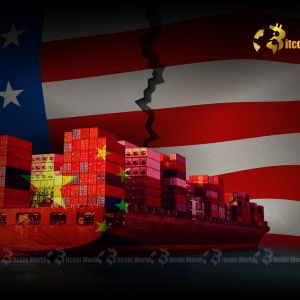Asia FX: Navigating Crucial Shifts Amidst Trade Tariffs and Strong Singapore GDP
7 min read
BitcoinWorld Asia FX: Navigating Crucial Shifts Amidst Trade Tariffs and Strong Singapore GDP The world of finance is a complex tapestry, and for those deeply entrenched in the dynamic cryptocurrency landscape, understanding broader macroeconomic trends is paramount. While digital assets often chart their own course, they are not immune to the gravitational pull of traditional markets. Currently, a significant narrative unfolding in Asia’s foreign exchange (FX) markets demands attention: a curious state of being ‘rangebound.’ This stability, or perhaps stagnation, comes at a time when global trade is being reshaped by escalating tariffs, yet pockets of surprising economic strength, such as Singapore’s recent GDP beat, offer a nuanced picture. How do these seemingly disparate elements coalesce, and what do they signify for the broader financial ecosystem, including the volatile world of digital currencies? Understanding Asia FX: Why Are Currencies Rangebound? The term ‘rangebound’ in financial markets refers to an asset whose price fluctuates within a relatively narrow band, showing no clear upward or downward trend. For Asia FX , this condition reflects a delicate balance of opposing forces. On one hand, persistent global uncertainties, primarily stemming from the ongoing trade disputes between the United States and China, exert downward pressure on regional currencies. Investors often shy away from riskier emerging market assets during times of heightened geopolitical tension, opting for traditional safe havens like the US Dollar or Japanese Yen. However, several factors provide underlying support, preventing a significant depreciation. These include robust current account surpluses in many Asian economies, relatively healthy foreign exchange reserves, and, in some cases, proactive central bank interventions aimed at maintaining stability. The region’s fundamental economic resilience, despite external headwinds, also plays a crucial role. This tug-of-war creates a scenario where currencies like the Chinese Yuan, Korean Won, and Malaysian Ringgit hover within defined trading ranges, reflecting a market grappling with conflicting signals. The lack of a decisive breakout often indicates that market participants are awaiting clearer direction on key global events, particularly those related to trade policy and central bank actions. The Shadow of Trade Tariffs: A Global Market Challenge Few topics have dominated headlines and investor anxieties more than the imposition of Trade Tariffs . These taxes on imported goods, primarily between the US and China, have created significant ripples across the Global Markets . Initially intended to address perceived trade imbalances, they have instead introduced substantial uncertainty into international commerce, disrupting established supply chains and impacting corporate profitability. The direct impact on Asian economies is multifaceted. Many nations in the region are deeply integrated into global supply chains, acting as manufacturing hubs for goods destined for Western markets. When tariffs are imposed, it increases the cost of these goods, potentially reducing demand and forcing companies to reconsider their production strategies. This can lead to: Supply Chain Relocation: Businesses explore moving production facilities out of tariff-hit countries, leading to capital expenditure and operational disruptions. Reduced Trade Volumes: Higher costs can dampen overall trade, affecting export-dependent economies. Investor Caution: The unpredictable nature of tariff escalations makes investors hesitant, leading to reduced foreign direct investment. Currency Volatility: Currencies of countries heavily reliant on trade with tariff-imposing nations often experience pressure. While the immediate impact might be felt in specific sectors, the broader sentiment of trade protectionism casts a long shadow over the Economic Outlook . Businesses become more conservative in their investment plans, and consumers may face higher prices, ultimately dampening global growth prospects. The market’s reaction to every tariff announcement or negotiation update underscores the profound influence these policies wield over investor sentiment and currency valuations. Singapore GDP’s Surprising Strength: A Beacon in the Economic Outlook? Amidst the prevailing concerns about global trade and a slowing world economy, Singapore delivered a notable surprise with its recent Gross Domestic Product (GDP) figures. The island nation’s economy expanded beyond expectations, providing a rare positive data point in a challenging environment. This strong performance in Singapore GDP offers a glimpse into potential resilience within the Asian region and warrants closer examination. What contributed to this unexpected strength? Several factors likely played a role: Resilient Services Sector: Singapore’s economy is increasingly diversified, with a strong emphasis on high-value services, including finance, technology, and professional services. This sector has shown robustness, helping to offset weakness in manufacturing. Strategic Economic Policies: The government’s proactive measures to support businesses and foster innovation may have cushioned the impact of external shocks. Regional Hub Status: Singapore’s role as a key financial and logistics hub for Southeast Asia continues to underpin its economic activity, drawing investment and talent. Specific Export Strengths: While manufacturing faced headwinds, certain high-tech or specialized export categories might have performed better than anticipated. This positive data point for Singapore GDP contrasts sharply with the gloomier forecasts for other trade-reliant economies in the region. It suggests that while the broad Economic Outlook remains cautious due to Trade Tariffs , individual economies with diversified structures and strong policy frameworks can demonstrate pockets of strength. For Global Markets , Singapore’s performance acts as a small, yet significant, reminder that not all news is negative, and careful differentiation between economies is essential. Navigating Global Markets: Strategies for Investors Amidst Uncertainty The current market environment, characterized by Asia FX being rangebound, the pervasive influence of Trade Tariffs , and a mixed Economic Outlook , presents both challenges and opportunities for investors across all asset classes, including cryptocurrencies. Understanding how to navigate these Global Markets requires a nuanced approach and a focus on resilience. For investors, particularly those with exposure to digital assets, the interplay between traditional finance and the crypto world becomes increasingly relevant. Here are some actionable insights: Diversification and Hedging: Asset Class Diversification: While cryptocurrencies offer unique growth potential, a balanced portfolio that includes traditional assets like bonds, equities, and even commodities can provide stability during periods of heightened volatility in either market. Geographic Diversification: As seen with Singapore GDP , economic performance can vary significantly by region. Spreading investments across different geographical markets can mitigate country-specific risks related to trade policies or domestic economic cycles. Currency Hedging: For those with significant international exposure, considering currency hedging strategies can protect against adverse FX movements, especially in rangebound markets where sudden breakouts can occur. Monitoring Key Indicators: Trade Policy Developments: Closely follow news and negotiations related to Trade Tariffs . Any resolution or escalation can trigger significant market reactions. Central Bank Policies: Decisions by major central banks (e.g., the Fed, ECB, PBOC) on interest rates and quantitative easing directly impact currency valuations and overall market liquidity. Economic Data: Beyond headline GDP figures, delve into manufacturing PMIs, inflation rates, employment data, and consumer confidence reports to gauge the true health of economies. The Role of Digital Assets: In times of traditional market uncertainty, some investors view cryptocurrencies, particularly Bitcoin, as a potential ‘digital gold’ or a hedge against inflation and geopolitical instability. However, their high volatility means they also carry significant risk. Understanding the correlation (or lack thereof) between crypto movements and traditional market events is crucial. While a rangebound Asia FX might suggest stability, the underlying tensions could still spill over into riskier assets. Conversely, a strong performance like Singapore GDP could signal broader confidence that might eventually trickle down. Challenges and Opportunities in the Current Economic Landscape The global economic landscape is a mosaic of challenges and emerging opportunities. The persistent threat of Trade Tariffs remains a significant headwind, threatening to derail global growth and exacerbate existing vulnerabilities. The uncertainty they create discourages long-term investment and can lead to a more fragmented global economy. Geopolitical tensions beyond trade, such as regional conflicts or political instability, also add layers of complexity, influencing capital flows and market sentiment. The overall Economic Outlook is thus characterized by caution, with many forecasters revising growth projections downwards. However, amidst these challenges, opportunities persist. The resilience shown by economies like Singapore, with its strong Singapore GDP performance, highlights the importance of economic diversification and sound domestic policies. This can lead to: Targeted Investment: Identifying sectors or countries that are less exposed to trade disputes or possess strong domestic demand can yield returns. Technological Advancement: The push for digital transformation and innovation continues across Asia, creating new avenues for growth and investment in tech-driven industries. Policy Responses: Central banks and governments have tools at their disposal to stimulate economies, from interest rate cuts to fiscal spending, which could provide future tailwinds. Evolution of Global Markets: The current environment is forcing a re-evaluation of global supply chains and trade relationships, potentially leading to new economic alliances and trade patterns. For those interested in Asia FX , the rangebound nature could also present tactical trading opportunities within defined limits, provided robust risk management is in place. The key is to remain agile, informed, and capable of adapting strategies as the global narrative evolves. Concluding Thoughts: A Complex Tapestry of Resilience and Risk The current state of Asia FX markets, characterized by their rangebound nature, is a microcosm of the broader global economic narrative. It reflects a delicate equilibrium where the pervasive uncertainty of Trade Tariffs clashes with underlying regional resilience and surprising pockets of strength, exemplified by the robust Singapore GDP figures. This dynamic interplay underscores the complexity facing investors navigating today’s Global Markets . For participants in the cryptocurrency space, these macroeconomic shifts are not merely distant headlines. They influence investor sentiment, capital flows, and the overall risk appetite that can significantly impact digital asset valuations. While the immediate Economic Outlook remains cautious, the ability of certain economies to defy expectations offers a glimmer of hope. Staying informed, diversifying portfolios, and understanding the intricate connections between traditional finance and emerging digital economies will be paramount for success in these evolving times. The markets are constantly recalibrating, and only those who adapt will thrive. To learn more about the latest Forex market trends and their impact on global economic outlook , explore our articles on key developments shaping international trade and currency movements . This post Asia FX: Navigating Crucial Shifts Amidst Trade Tariffs and Strong Singapore GDP first appeared on BitcoinWorld and is written by Editorial Team

Source: Bitcoin World



